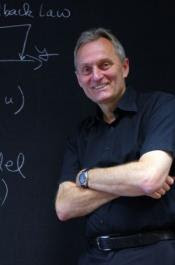Speaker
Description
Different avenues exist for the thermodynamically consistent modeling of open multi-physical systems with reversible-irreversible couplings. Thermodynamically consistent means that both the first (energy conservation) and the second (entropy production) law of thermodynamics are reflected in the model structure and the numerical schemes derived therefrom.
Founded on the port-Hamiltonian paradigm, which emerged from combining and generalizing network theory and Hamiltonian mechanics, and which is closely related to the bond graph language, several formulations have been proposed: quasi-Hamiltonian, port contact systems, reversible-irreversible port-Hamiltonian systems (riPHS), exergetic PHS or port-thermodynamic systems from a Liouville geometry point of view. The dynamcis in these formulations is in principle generated by the total energy or a homogeneous Hamiltonian as the single potential. All approaches directly include ports and interfaces with a (control) environment, whose role has recently been investigated from a geometric perspective.
Differently, in formulations like GENERIC or metriplectic systems, recently proposed in a four-bracket formulation, the dynamics is derived from two generators, the energy and the entropy, as potentials. The port-based perspective is not at the origin of these approaches, yet extensions to the open case have already been sketched. Finally, thermodynamic systems and their interconnections can be modeled via variational principles, similar to the ones for non-holonomic mechanical systems.
To mimic the fundamental physical properties of the models at a discrete level, structure-preserving numerical methods have to be constructed. In particular (but not only) for the GENERIC formulation, energy-momentum-entropy (EME) preserving schemes have been developed and successfully applied for the simulation of coupled phenomena as from thermo-visco-elasticity.
The main purpose of this talk is to present the different energy- and entropy-based formulations of a discrete thermo-visco-elastic model problem and to discuss their properties and relations, in particular in view of the free choice of thermodynamic variables, which is facilitated by a special form of GENERIC proposed by Mielke (2011). We highlight structure preservation under numerical integration on the finite-dimensional case and close with comments on spatial discretization and simulation examples.

